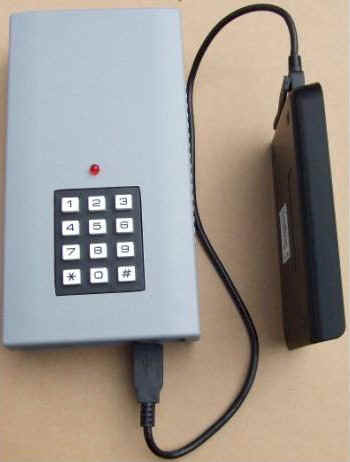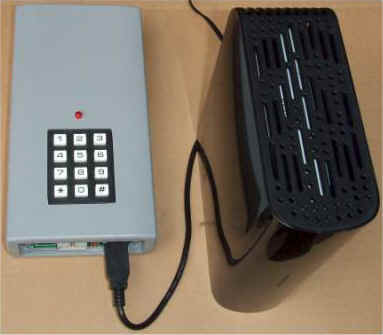
Telephone audio server and audio archive
General
considerations
The
growing popularity of podcasting, “audio on demand” and the proliferation
of MP3 songs and audiobooks have created the need to organize such a
collection of sounds into an audio archive.
A typical solution for an audio archive/server consists of a PC with
USB mass storage for audio files. The
purpose of this embedded telephone audio archive is to retain the USB storage
but use a low cost custom-made module, the MPT3 or MPT4, instead of a PC.
This results in a lower overall cost, substantial power savings and
significant environmental benefits resulting from eliminating the PC in the
final product. Additional
benefits include almost instantaneous access to audio files which are literary
at the user’s fingertips – the files are selected in a similar manner as
dialing a telephone number. The
selection of files and navigation in this embedded archive can be done through
RS232 interface and/or by pressing keys on standard decimal passive keypads
one mounted on the box and the other (extended, mouse-like) connected to the
archive’s box with a ribbon cable.
Additionally, the MPT3 card only feature interface to a standard corded or
cordless telephone (connection to PSTN network can be achieved with an
external modem). With the
cordless telephone, only the base is connected to the MPT3 and the archive is
controlled using the handset’s keypad.
With modern cordless phone range being several hundred meters, the
handset acts like a remote control unit with the range of up to several
hundred meters. The played audio
can be heard through the handset. Some
application may use the handset only as a remote control when the archive’s
audio output is connected to a hi-fi or public address system.
It would be then possible to control the home hi-fi from the swimming
pool or the BBQ area in the backyard. The
public address system at sporting venues, lecture halls, shops and similar
places could be controlled in a similar manner.
The MPT4 card features, instead of a telephone interface as in MPT3, an
interface to the PSTN network using an on-board embedded modem. An archive based on the MPT4 card can be simply dialed up
from any telephone that supports DTMF signaling.
The audio files are then selected, listened to and navigated remotely
using the phone’s keypad in exactly the same way as directly through the
keypad on the box.
Embedded implementation of telephone audio archive
To implement telephone audio server/audio archive function the following
sound cards can be used: MPT3 in a standard box, MPT4 in a standard box or MA47
Eurocard fitted into a 19" 3U rack.
The MPT3 and MPT4 differ in the following:
MPT3: does not have on-board socket modem but can be connected to PSTN
telephone network via external modem using dedicated RS-232 interface; it has
interface to a corded or cordless telephone which can be used to access audio
archive remotely (at short distance if using cordless phone) without using PSTN connection. With MPT3 it is possible to use both the
PSTN connection and direct telephone connection to access the audio archive.
MPT4: has on board socket modem for direct connection to a PSTN network; does
not have direct interface to a telephone. The MA47 has the same functionality as the MPT4.

This simple server consist of the MPT4 sound card placed in a standard 100 x 190 mm box and a 320GB portable USB hard drive. The power to the hard drive is supplied via USB connection.
12V DC power supply and PSTN cable terminated with RJ11 plug (Tip and Ring only) are connected directly to the MPT4 card in the box.
A good quality MP3-encoded speech is achieved using 32kbps sampling rate which requires 4k bytes of memory per second. With longer audio files like audiobooks the available memory space is close to the hard disk's capacity. This server can thus store up to 80 million sec or 22 000 hrs or 3700 6h long audiobooks.
 This
server consist of the MPT4 sound card placed in a standard 100 x 190 mm
box and 1TB external USB hard drive. The 12V power to the hard drive is
supplied separately.
This
server consist of the MPT4 sound card placed in a standard 100 x 190 mm
box and 1TB external USB hard drive. The 12V power to the hard drive is
supplied separately.
12V DC power supply and PSTN cable terminated with RJ11 plug (Tip and Ring only) are connected directly to the MPT4 card in the box. With 32kbps sampling rate, which requires 4k bytes of memory per second, this server can store up to 250 million sec or 69 000 hrs or over ten thousand 6h long audiobooks. The British Library Sound Archive claims to be the largest in the world with its 3.5 million recordings. It would be possible to place 1 min samples of each recording on this server.
Applications
* Remote access to audio archives via any telephone
supporting DTMF signaling -
such remote access may be desired for applications such as audio
guides and
interactive information systems, browsing via
telephone in audio collections of
educational institutions, law courts and information services,
audiobook lending
libraries (especially for the blind), radio stations' podcasts (to
complement
internet-based servers) and various audio-on-demand systems.
* Self publishing artists like singers, musicians and voiceover talents wishing
for their
sound collection to be instantly available over the phone.
* Phone based training and learning, language studies.
* Computer telephony applications.
* Alarm systems - autodialing and remote monitoring of sites and
equipment.
* Conversational answering machines.
See also Description of the embedded demo audio archive,
Audio file management in the archive and
MP3 player/audio archive for
home and car for additional information.
pdf file of this page - Telephone audio server and audio archive